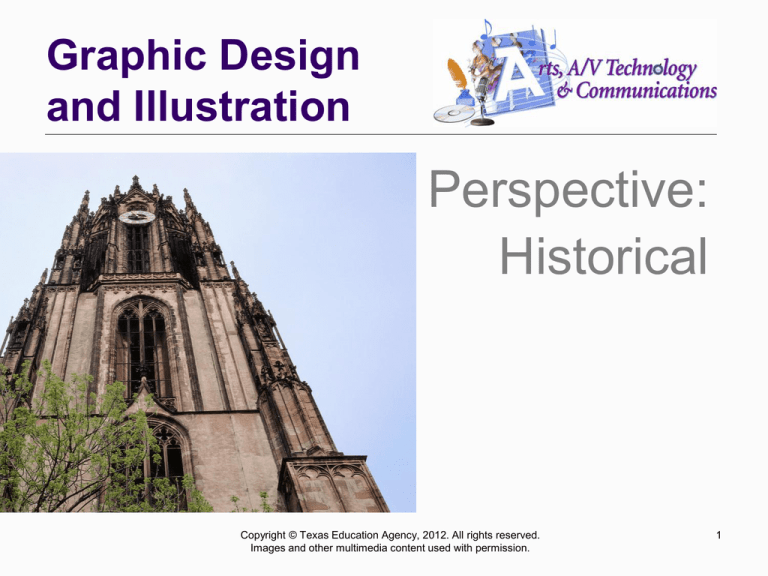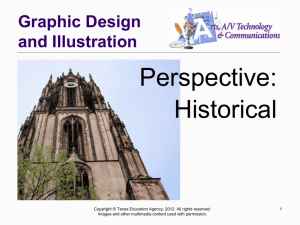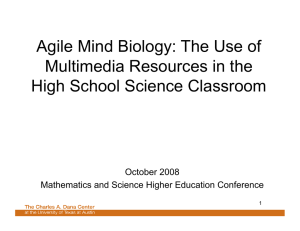Perspective: Historical Graphic Design and Illustration
advertisement

Graphic Design and Illustration Perspective: Historical Copyright © Texas Education Agency, 2012. All rights reserved. Images and other multimedia content used with permission. 1 Definition of Perspective Perspective is a graphic system that creates the illusion of depth and volume on a two-dimensional surface. Copyright © Texas Education Agency, 2012. All rights reserved. Images and other multimedia content used with permission. 2 Artists use six main techniques to give their artworks perspective. (1) They overlap objects, where one object covers part of a second object, and the first object seems to be closer to the viewer. (2) They include differences in size, where large objects appear to be closer to the viewer than small objects. Copyright © Texas Education Agency, 2012. All rights reserved. Images and other multimedia content used with permission. 3 Artists use six main techniques to give their artworks perspective. (3) They place objects at different levels on the picture plane. Objects that are lower on the picture plane appear closer to the viewer than objects placed further up on the picture plane. (4) They include differences in detail. Things that are further away have less detail. Copyright © Texas Education Agency, 2012. All rights reserved. Images and other multimedia content used with permission. 4 Artists use six main techniques to give their artworks perspective. (5) They alter the value and intensity of colors. Objects further away are less vivid, duller, or flatter in color. (6) They incorporate converging lines to show distance and depth. To create the illusion of forms and depth, artists must try to represent the way we perceive things in real life. http://www.glencoe.com/sec/art/art_talk/students/chapter5.php/tx Copyright © Texas Education Agency, 2012. All rights reserved. Images and other multimedia content used with permission. 5 Art Before Perspective The system of perspective we take for granted today is a relatively recent discovery in artistic history. Before the 14th Century little to no attempts were made to realistically depict the three-dimensional world in art in the way in which we are now accustomed to seeing it. The art of the Byzantine, Medieval, and Gothic periods was rich and beautiful, but the images made no attempt to create the illusion of depth and space. Copyright © Texas Education Agency, 2012. All rights reserved. Images and other multimedia content used with permission. 6 The Calling of the Apostles c.1308-1311 Duccio di Buoninsegna The Italian masters Giotto (c. 1267 – 1337) and Duccio (c. 1255-1260 – c. 1318-1319) began to explore the idea of depth and volume in their art and can be credited with introducing an early form of perspective, using shadowing to great effect to create an illusion of depth, but it was still far from the kind of perspective we are used to seeing in art today. Copyright © Texas Education Agency, 2012. All rights reserved. Images and other multimedia content used with permission. 7 First Perspective – Fillipo Brunelleschi and Masaccio The first known picture to make use of linear perspective was created by the Florentine architect Fillipo Brunelleshi (1377-1446). Painted in 1415, it depicted the Baptistery in Florence from the front gate of the unfinished cathedral. The linear perspective system projected the illusion of depth onto a two-dimensional plane by use of ‘vanishing points’ to which all lines converged at eye level, on the horizon. Soon after Brunelleshi’s painting, the concept caught on and many Italian artists started to use linear perspective in their paintings. Copyright © Texas Education Agency, 2012. All rights reserved. Images and other multimedia content used with permission. 8 Masaccio (1401 – 1428) the first great painter of the early Renaissance period, was the first artist who demonstrated full command of the new rules of perspective; the figures in his paintings have volume and the buildings and landscapes realistically recede into the distance. Masaccio is seen now as being the initiator of the new style of Florentine Realism. Copyright © Texas Education Agency, 2012. All rights reserved. Images and other multimedia content used with permission. 9 By the late 15th Century, artists were in total command of perspective and were able to create in their art a beautiful and realistic world. The great painters of the time were using the system first created by Brunelleschi to wonderful effect. Underlying these changes in artistic method and the use of perspective was a renewed desire to depict the beauty of nature, and to unravel the axioms of aesthetics, with the works of Leonardo, Michelangelo, Raphael, Botticelli, Donatello, and Titian representing artistic pinnacles that were to be much imitated by other artists. http://www.op-art.co.uk/history/perspective.html Copyright © Texas Education Agency, 2012. All rights reserved. Images and other multimedia content used with permission. 10 Before: Giotto, Lamentation over Jesus, 1305 http://ftp.aa.edu/lydon/Art07/ArtProject/paige_giotto/index.htm After: Raphael. Marriage of the Virgin. 1504 http://www.rosanne-lester.com/projects/art400.html Copyright © Texas Education Agency, 2012. All rights reserved. Images and other multimedia content used with permission. 11

